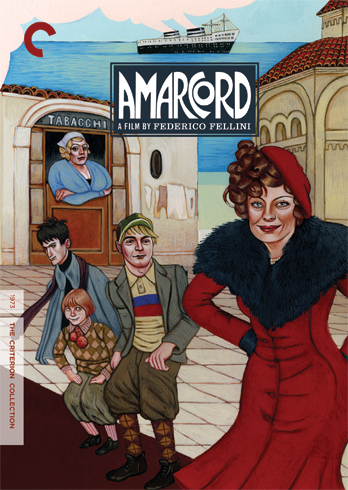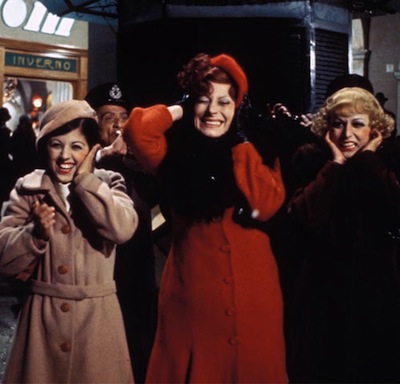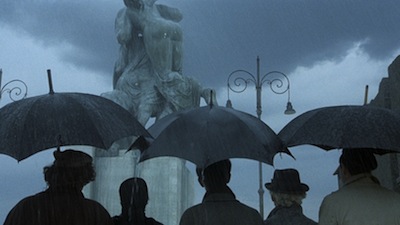
Amarcord is the memoir of a prankster.
Federico Fellini's 1973 masterpiece, the title of which translates as "I Remember," is a playful collection of memories. It runs through both the filmmaker's personal history and also his films, creating echoes of his previous work as he exposes what may be the true inspirational origins for some of his more famous characters and scenes. In the crazed nymphomaniac Volpina, for instance, we see another version of the woman who was also Seraghina in 8 1/2 [review]. The childhood chums on the verge of manhood will eventually step out of this movie and star in I Vitelloni.
The maestro constructs Amarcord as a sort of greatest hits of one year in the life of the seaside village where he grew up, set in the early days of fascism and the reign of Mussolini. Beginning with the arrival of the "puffballs," airborne spores that signal the beginning of spring, he takes us through the seasons, from the leisure of summer to the foggy confusion of autumn and the wondrous cold of winter. It ends with the puffballs returning, a natural bookending. There are many continued rhymes through Amarcord, repetitions and reappearances, riding through the film's loose narrative like the man on the motorcycle who consistently arrives to split the town's activity right down the middle. There is also a sort of circle of life represented: we begin with the birth of spring and work our way to cold death. The spring festival that kicks off the movie, burning a witch in effigy, foreshadows a real death in the penultimate act of the film, but also the wedding that closes it. In surrendering the town's most desired romantic figure to married life, everyone is acknowledging that one phase of their existence is gone for good. Yet, marriage is for making babies, and so the cycle will begin anew.

There is a huge cast of characters running through Amarcord, but the Biondi family could be considered the focal point of most of the story. Titta Biondi (Bruno Zanin) is possibly Fellini himself. He dreams of sex and cinema, fantasizing about doing things that will bring him renown, like being a famous race car driver. He's still pretty immature--his mother won't buy him long pants, and his striped sweater and rainbow hat make him look like he has stepped out of an old newspaper comic strip--and his hormones are out of control, meaning sex trumps cinema any day of the week. It's fitting, though, that he makes his move on the gorgeous hairdresser Gradisca (Magali Noël) in a movie theatre while she watches her dream man, Gary Cooper. "Gradisca" means "whatever you desire," and while that isn't really the mantra of Amarcord, it is a theme just under the surface. Passions run hot in this town, and though much of that fire is devoted to boobs and butts, there is much to suggest that "getting out" is going to be the only goal that matters. Gradisca will be departing now that she has finally found the romance she has been searching for. The two biggest events that happen to the village are also all about passing through on the way to somewhere else: the Mille Miglia car race that winds its course through their streets, and the arrival of the Rex, a gargantuan cruise liner that the locals sail over the waves just to see float by.

Fellini takes us all through life in this town. We go to school and work, home and church. We watch people cruise the streets at night, and visit the local hotel resort to dance and sunbathe. We even see their politics, as many get uniformed up for a rally honoring Il Duce. In one of Amarcord's most surreal and comical moments, a giant Mussolini head that's been constructed out of flowers begins talking, granting the horny boy Ciccio (Fernando De Felice) his fondest wish: marriage to the dark beauty Aldina (Donatella Gambini). This is followed by the film's blackest moment, Titta's father (Armando Brancia) is taken from the house in the middle of the night to be questioned by the fascists. Someone has ratted the old man out for having contrary political beliefs. The pomp and circumstance and small-town go-along mentality is quickly busted by the thuggish behavior of their chosen leaders.
Amarcord is structured as a series of short scenes, strung together as nostalgic reverie. It's a shared experience, and there are multiple narrators. Though the lawyer (Luigi Rossi) gets the most lines, any townsperson can turn to the camera and start talking. A community like this really forms a single history, one that can only be chronicled in widescreen. Fellini and his cinematographer Giuseppe Rotunno use the full length of the frame, creating colorful and complicated set-ups. Amarcord is a masterfully orchestrated melding of dreamscape and reality. It is truth filtered through the prism of recollection, grandly staged like Golden Age cinema, but with the flourish of classical painting. There is also an element of poetry to this. The references to Dante and Leopardi aren't for nothing, each sequence could be the stanza of an epic poem or the movements of a symphony (here, of course, orchestrated by the genius Nino Rota). Watch, too, how Fellini moves from one segment to the next, using heavy fades to go to black before coming back up on the next scene. It's like blinking. Close your eyes, and when you open them, new magic appears.
To try to divine the reality from the fiction in Amarcord would be a pointless effort. Fellini himself has denied its autobiographical nature, but not without a wink to say, "Well, resemblance to actual events may be more than coincidental." This is the ultimate prank of the movie, to bury the actual in spectacle, and to lend authenticity to what is clearly false. All art is reconstruction, all cinema is simulacrum, and Amarcord is its own cake, feeding on itself by being neither and both all on one plate.
This new Blu-Ray is the third version of Amarcord from Criterion, though it closely mirrors the previous DVD reissue

This disc was provided by the Criterion Collection for purposes of review.

No comments:
Post a Comment